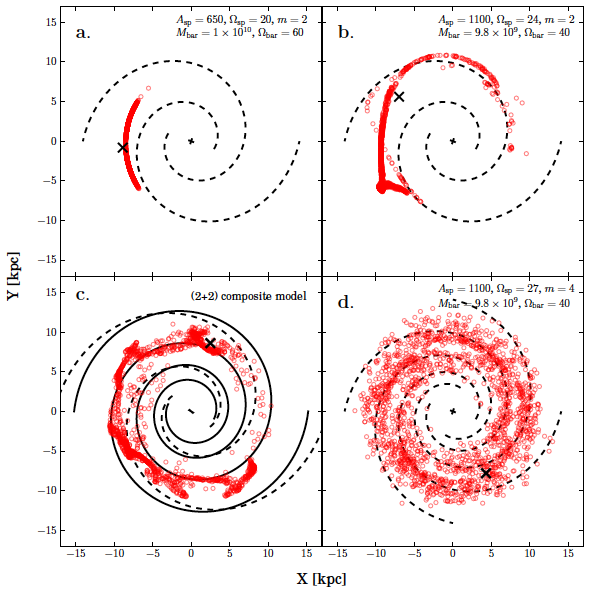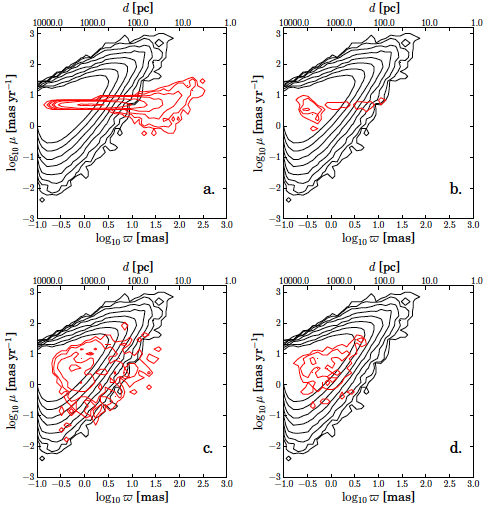IoW_20160204 - Gaia
Image of the Week |
|||
Searching for solar siblings with Gaia |
|||
 |
|||
| Figure 1: The red circles denote the possible present-day distributions of solar siblings in the disk of the Milky Way. Each panel corresponds to a specific set of Milky Way model parameters. The dashed black lines represent the shape of the Galactic spirals arms in each case. The solid lines in the bottom left panel represent the spiral arms of the Galaxy in a composite model in which two arms have different pattern speed and amplitude compared to the other two arms. The black crosses in the panels mark the location of the Sun's birth cluster 4600 million years ago. In the simulations, this position is assumed to be at 9 kpc from the Galactic centre. Here, the Sun's birth cluster has an initial mass of 1023 solar masses and a radius of 2 parsec. | |||
|
Some 4600 million years ago, the Sun was born in a cluster, i.e., in a clump of stars that interact gravitationally and share the same age, metallicity and chemical composition. Evidence for this birth environment can be observed in the Solar System. For instance, the decay products of radioactive elements found in the meteorite fossil record suggest that a supernova explosion occurred near the Sun, during or shortly after the formation of the Solar System. Additionally, the large eccentricities of the orbits of objects located in the Edgeworth-Kuiper belt are thought to be a consequence of close encounters experienced by the Sun and other stars that once belonged to the birth cluster. The intense gravitational tidal field of the Galaxy dispersed the Sun's birth cluster 2400 million years ago. As a consequence, the stars that were born together with the Sun, the so-called solar siblings, might be currently dispersed all over the Galactic disk. The present-day distribution of solar siblings can be predicted by performing numerical simulations of the evolution of the Sun's birth cluster in a realistic model of the Galaxy. However, such a distribution will not be unique, given the uncertainties in the Galaxy model and its parameters. Martínez-Barbosa et al. (2016) carried out N-body simulations of the Sun's birth cluster to predict the current location of the solar siblings in the Milky Way. These simulations include the gravitational forces within the cluster, the effects of stellar evolution on the cluster population and the gravitational force due to the Galaxy. Figure 1 shows the possible spatial distributions the solar siblings might have right now, according to the numerical simulations performed by Martínez-Barbosa et al. (2016). In a Galaxy model containing two spiral arms (top panel), the solar siblings can be very close to each other in radius and azimuth, meaning that they have a similar motion around the Galaxy. In less optimistic cases, the solar siblings might be rather dispersed in the Galactic disk (bottom panel). This occurs at considering four spiral arms (bottom right panel) or at considering a Galaxy model with a composition of spiral arms with different amplitudes and angular velocities (bottom left panel). If field disk stars were overlaid on each panel of Figure 1, it would not be possible to distinguish between solar siblings and other disk stars. Hence, it is necessary to develop specific techniques to search for solar siblings in the future. One of these techniques, which was introduced by Brown et al. (2010) and later revised by Martínez-Barbosa et al. (2016), consists of searching for solar siblings in the space of astrometric observables (parallaxes, proper motions and radial velocities). The procedure is illustrated in Figure 2. First, every predicted distribution of solar siblings is compared to the distribution of disk stars, as Gaia will see them. This comparison is made in order to find regions in the space of astrometric observables where the contrast between the solar siblings and disk stars is high. By making statistics over a broad range of possible Galactic parameters and initial conditions of the Sun's birth cluster, Martínez-Barbosa et al. (2016) found that the region where solar siblings are most reliably detected - and discriminated from disk stars through their kinematics - is at parallaxes larger than 5 mas, proper motions between 4 and 6 mas yr-1 and radial velocities between -2 and 0 km s-1. Selecting stars from this region will increase the probability of identifying solar sibling candidates. In this respect, the upcoming data from Gaia and other observational campaigns will be essential. However, it is also necessary to determine precisely the age, metallicity and chemical composition of these stars in order to find the solar family. The identification of solar siblings will provide information on the environment where the Solar System was formed and on the place in the Galaxy where the Sun was born. |
|||
 |
|||
| Figure 2: Distribution of solar siblings (red contours) and simulated Gaia data for disk stars (black contours) in the proper motion vs. parallax plane. Each panel corresponds to the distributions shown in Figure 1. The disk stars were simulated using the Gaia Universe Model Snapshot. | |||
|
Credits: Carmen Adriana Martínez Barbosa (Leiden Observatory, Leiden University) [Published: 04/02/2016] |
|||
- Removed a total of (15) style text-align:center;
- Removed a total of (4) style text-align:justify;
- Removed a total of (1) border attribute.
- Removed a total of (1) cellpadding attribute.
- Removed a total of (1) cellspacing attribute.
Image of the Week Archive
- Removed a total of (1) border attribute.
- Removed a total of (1) cellpadding attribute.
- Removed a total of (1) cellspacing attribute.








































 Sign in
Sign in
 Science & Technology
Science & Technology
